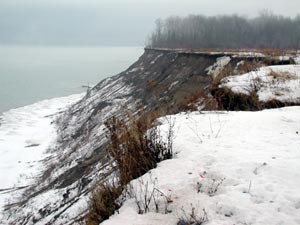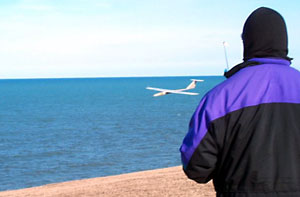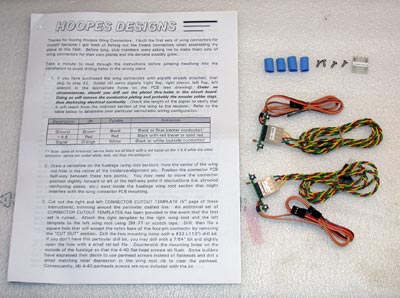CLASS F3F – RADIO CONTROL SLOPE SOARING
5.F.1. Definition: This contest is a speed event for radio controlled slope gliders. A minimum of four rounds must be flown. The organiser shall run as many rounds as the conditions and time permit, up to a maximum of ten rounds.
5.F.2. Characteristics of Radio Controlled Slope Gliders
Maximum surface area (St) …………..150 dm2
Maximum flying mass …………………….5 kg
Loading on St ………..between 12 and 75 g/dm2
The radio shall be able to operate simultaneously with other equipment at the normally used spacing in the allocated R/C bands (i.e. 35 MHz : 10 kHz).
The competitor may use two models in the contest. The competitor may combine the parts of the models between the rounds provided the resulting model used for flight conforms to the rules and that the parts have been checked before the start of the contest. Addition of ballast (which must be located internally in the model) and/or change of angles of setting are allowed. Variation of geometry or area is allowed only if it is actuated at distance by radio control.
5.F.3. Competitor and Helpers: The competitor (pilot) must operate his radio equipment personally. Each pilot is permitted one helper. The helper is only to assist and advise the pilot until the model is passing Base A for the first time and after the timed flight is completed.
5.F.4. Definition of an Attempt: There is an attempt when the model has left the hands of the pilot or his helper.
5.F.5. Number of Attempts: The pilot has one attempt on each flight. An attempt can be repeated if:
a) the launching attempt is impeded, hindered or aborted by circumstances beyond the control of the pilot, duly witnessed by the official judges;
b) his model collides with another model in flight or other impediment and the pilot is not to blame on that account;
c) the flight was not judged by the fault of the judges.
5.F.6. Cancellation of a Flight: A flight is official when an attempt is carried out, whatever result is obtained.
A flight is official but gets a zero score if:
a) the pilot used a model not conforming with FAI rules;
b) the model loses any part while airborne;
c) the helper advises the pilot during the timed flight;
d) the model is controlled by anyone other than the pilot;
e) the flight is not carried through;
f) the model lands outside the assigned landing area;
g) the model is not launched within one minute from the moment the starting order is given.
5.F.7. Organisation of Starts: The flights are to be performed round by round. The starting order is settled by draw in accordance with the radio frequencies used.
The pilot is entitled to three minutes of preparation time from the moment he is called to the ready box.
After the three minutes has elapsed, the starter may give the order to start. After the starter has given the order to start, the pilot or his helper is to launch the model within one minute. The pilot or his helper is to launch the model by hand from the starting area indicated by the organiser.
If possible, the starting area, including the audio system, shall be situated in the middle of the course (equal distance from Base A and Base B).
The time from launch to the moment the model enters the speed course must not exceed thirty seconds.
If the model has not entered the speed course (i.e. first crossing of Base A in the direction of Base B)] within the thirty seconds, the flight time will commence the moment the thirty seconds expires. If the model has not entered the speed course within the thirty seconds, this is to be announced by the judges.
5.F.8. The Flying Task: The flying task is to fly 1000 metres on a closed speed course of 100 metres in the shortest possible time from the moment the model first crosses Base A in the direction of Base B.
5.F.9. The Speed Course: The speed course is laid out along the edge of the slope and is marked at both ends with two clearly visible flags. The organiser must ensure that the two turning planes are mutually parallel and perpendicular to the slope.
Depending on the circumstances, the two planes are marked respectively Base A and Base B.
Base A is the official starting plane. At Base A and Base B, an Official announces the passing of the model (i.e. the centre of gravity) with a sound signal when the model is flying out of the speed course. Furthermore, in the case of Base A, a signal announces the first time the model is crossing Base A in the direction of Base B.
5.F.10. Judging: The flights are judges by two judges who do not have to be the same for all competitors.
The judges’ task is to control that the flights are performed according to the rules, to be time keepers and to ensure that the right distance is flown.
5.F.11. Scoring: The result of the flight is stated as the time in seconds and hundredths of seconds obtained by each pilot. For the purpose of calculating the result of the round, the competitor’s result is converted this way:-
P1
1000 X ——–
PW
where PW is the best result in the round, and PI is the competitor’s result.
5.F.12. Classification: The sum of the competitor’s round scores will determine his position in the final classification. The lowest round score of each competitor will be discarded and the others added to obtain the final score which will determine his position in the final classification.
To avoid ties in the classification concerning the five best scores, “classification rounds” are flown until the ties are broken. If this is not possible, the result of the discarded round will determine each competitor’s position in the final classification.
5.F.13. Organisation of the Contest: The competition must be held at a site which is suitable
5.F.14. Changes: Any changes in the flight and landing areas may be made only between flight rounds.
5.F.15. Interruptions: A round in progress must temporarily be interrupted if:-
a) the wind force unintermittently is below 3 m/sec or more than 25 m/sec.
b) the direction of the wind unintermittently deviates more than 45d from a line perpendicular to the main direction of the speed course.
A round in progress is to be cancelled if:-
a) the interruption lasts more than thirty minutes;
b) fewer than 50% of the competitors have been able to perform the task caused by marginal conditions. Without the condition “unintermittently” (i.e. 20 seconds) have been met and thus automatically caused reflights.









